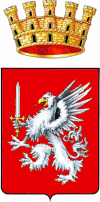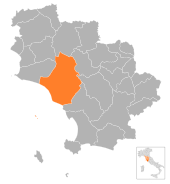Grosseto
| Grosseto | ||
|---|---|---|

|
|
|
| Country | Italy | |
| region | Tuscany | |
| province | Grosseto (GR) | |
| Coordinates | 42 ° 46 ' N , 11 ° 7' E | |
| height | 10 m slm | |
| surface | 474.46 km² | |
| Residents | 82,378 (Dec. 31, 2019) | |
| Population density | 174 inhabitants / km² | |
| Factions | Alberese, Batignano , Braccagni, Istia d'Ombrone , Marina di Grosseto , Montepescali , Nomadelfia, Principina a Mare, Principina Terra, Rispescia, Roselle | |
| Post Code | 58100 | |
| prefix | 0564 | |
| ISTAT number | 053011 | |
| Popular name | Grossetani | |
| Patron saint |
San Lorenzo (August 10th) |
|
| Website | Grosseto | |
 Panorama of Grosseto |
||
Grosseto is a city in the Italian region of Tuscany with 82,378 inhabitants (as of December 31, 2019). It is the capital of the province of Grosseto and the center of the Maremma region .
geography
The community extends over around 474 km² . It is located about 140 km south of Florence in the Maremma landscape in the climatic classification of Italian communities in zone D, 1550 GG.
The once universally marshy plain of Grosseto is in the west by the Tyrrhenian Sea , north of the rich in ancient mineral resources metalliferous hills to the east of Monte Amiata massif and to the south by the mouth of the river Ombrone within the Parco Naturale della Maremma limited . The river Bruna flows in the eastern municipality .
The districts (frazioni) include Alberese (42 meters in altitude, approx. 350 inhabitants), Batignano (150 m, approx. 600 inhabitants), Braccagni (19 m, approx. 900 inhabitants), Istia d'Ombrone (39 m, approx. 1,150 inhabitants), Marina di Grosseto (1 m, approx. 2,000 inhabitants), Montepescali (222 m, approx. 300 inhabitants), Principina a Mare (3 m, approx. 150 inhabitants), Principina Terra (also called La Principina , 4 m, approx. 290 inhabitants), Rispescia (also called Santa Maria di Rispescia , 15 m, approx. 650 inhabitants) and Roselle (25 m, approx. 1,400 inhabitants).
The neighboring municipalities are Campagnatico , Castiglione della Pescaia , Gavorrano , Magliano in Toscana , Roccastrada and Scansano .
history
The city dates from the Middle Ages. Individual ancient stones that were found here do not suffice as evidence that the Etruscans , who maintained two flourishing ports of the Twelve Cities in the immediate vicinity with Vetulonia and Roselle , would have been here; Nothing is known about integration into the Roman Empire either.
In August 803 the small church Chiesa di San Giorgio and its lands were taken over by the feudal lord Lamberto di Ildebrando Aldobrandeschi , whose successor ruled the Maremma ( Scarlino ) until the 12th century . On the Via Aurelia there was a small fort and a post office.
The upswing came in 1138 with the relocation of the bishopric from Roselle, which was destroyed by the Saracens , to Grosseto , at the instigation of Pope Innocent II. This is where the name Grossetum is correctly documented for the first time, which in less reliable sources also in other variants ( Crassetum or Rosetum ) circulated. The city is called Grossetum in the bulls of later popes.
At the beginning of the 13th century, the Aldobrandeschi were oppressed from two sides by the demands of the citizens for the establishment of an autonomous city republic on the one hand and by Siena's claim to submission to their control on the other. The conflict between the Guelphs (Aldobrandeschi) and Ghibellines (Siena in association with Emperor Frederick II , who was a guest of the city in 1224, set cultural accents and tried to settle disputes) lasted until 1336 with varying results, before Grosseto finally passed to Siena fell.
Revolts against the Senese rule took place again in 1430 and 1527 , in 1528 they fended off a corsair attack by Cheir ed-Din Barbarossa and in 1552 drove out the Spanish troops of Charles V , who had occupied Siena before three years later the Medici claimed.
With the final fall of Siena in 1555 Grosseto thus came to Florence , which in 1569 an imperial Grand Duchy - Tuscany under - I. Cosimo had become. The Medici princes showed little interest in the area, in which over the centuries, due to the increasing swamping of the Maremma due to the neglect of the ancient drainage systems, an unsuitable climate had set in and malaria was rampant. In 1745 this disease had reached such proportions that Grosseto only had 648 inhabitants, even though in 1224 it had more than 3,000 men in arms.
The situation only changed under the Habsburg Grand Duke Leopold II in the 19th century, who started a pilot project to drain the swamps, create a canal system comparable to that of antiquity and reforest the area through pine forests ( la bonifica ). This made the city habitable again, although the water kept coming back and the malaria had not been eradicated. In 1836 the population had increased again to 2,392 inhabitants. Decades later, the provincial headquarters were relocated to Scansano in the summer .
During the Risorgimento era , the city voted for the republic.
The bonifica work was forcibly continued under Benito Mussolini with prisoners and veterans from the Veneto who had become landless during the First World War, under massive propaganda.
In the 1950s, DDT put an end to the malaria pathogen for good.
Since 1945 the city of Grosseto has grown four times.
coat of arms
The griffin was already known as an emblem among the Etruscans. The thesis is therefore circulating that by choosing this mythical creature, the Grossetanians wanted to evoke an ancient origin that did not actually exist. On the other hand, the griffin appears in numerous city coats of arms without an ancient past. The sword is intended to commemorate the fight against the Ghibellines , in particular the expulsion of the troops of Ludwig of Bavaria in 1328.
Attractions
- The historic center of the city is surrounded by fortifications commissioned by the Medici Grand Dukes Franz I (1574–1587) and Ferdinand I (1587–1609). These form a hexagonal enclosure with protruding bastions, which is only broken through by two gates. The wall ring is accessible and is lined with green spaces.
- In the central Piazza Dante , where the Aldobrandeschi castle was once located, the neo-Gothic palace of the provincial government (1900) and the Cathedral of San Lorenzo, begun in 1294, were built in characteristic Italian Gothic (alternating red and light beige limestone) (restored in 1855). In the piazza, Leopold II is a memorial because of his recultivation and drainage program in the Maremma. Malaria is symbolically represented as a snake that the hero crushes.
- The Franciscan church from the 13th century with cloister contains frescoes from the 14th century and a crucifix that is attributed to Duccio di Buoninsegna .
- The Museo Archeologico e d'Arte della Maremma has an extensive collection of Etruscan finds and Senese art.
- The citadel was built by the Senese in 1311.
Regular events
- La merca: La merca is a still preserved shepherd ceremony in the rural area, held in May to mark the calves born in the herd during the year for the purpose of official admission to the herd.
- The singing on May 1st: goes back to peasant traditions, before it also had politically and socially critical implications towards the end of the 19th century. The “corn singers” ( maggiolatori ) still go from house to house in some areas in costumes with the accordion on the night of April 30th to May 1st. They distribute small bouquets of flowers to the children and receive eggs, cheese, wine and other food in return.
Sports
- The local soccer team is called Unione Sportiva Grosseto Football Club 1912 and, after a short interlude in Serie B, plays again in the third-class Lega Pro Prima Divisione . Some of the nationally known players in Italy began their careers with this club.
- The baseball club BBC Grosseto was three-time national champion in Italy.
- Some personalities in Italian boxing also come from Grosseto.
Economy and Transport
The economic basis is mainly the service sector (tourism, especially in the districts on the coast). Agriculture also plays a role and has preserved its historical traditions (cereals, citrus fruits, fruit and vegetables on the plains, vineyards and olive growing on the hills). The Morellino di Scansano and the locations near Pitigliano are known nationwide.
There is an important military airfield near Grosseto , where the Italian Air Force stationed its first Eurofighter Typhoon ( 4º Stormo ). The airfield is also open to a limited extent for civil air traffic; regional flights are offered seasonally.
Two important, four-lane long-distance routes meet in Grosseto. On the one hand the SS1 variant Aurelia , which can be reached via the four junctions Grosseto nord, Grosseto- Roselle , Grosseto est and Grosseto sud. On the other hand, there is a connection to Siena or Florence at the Grosseto - Roselle junction , namely the state road SS 223 di Paganico . Both routes have a very high priority and are therefore also European routes , the SS1 is part of the E80, the SS223 of the E78.
The traditional cavalry regiment Savoia Cavalleria has been stationed in Grosseto since 1995 .
Town twinning
-
 Birkirkara , Malta
Birkirkara , Malta
-
 Cottbus , Germany
Cottbus , Germany
-
 Dimitrovgrad , Bulgaria
Dimitrovgrad , Bulgaria
-
 Kashiwara , Japan
Kashiwara , Japan
-
 Montreuil , France
Montreuil , France
-
 Narbonne , France
Narbonne , France -
 Saintes-Maries-de-la-Mer , France
Saintes-Maries-de-la-Mer , France
sons and daughters of the town
- Andrea da Grosseto (* 13th century; † unknown), translator and poet
- Otmar Nussio (1902–1990), Swiss conductor and composer
- Luciano Bianciardi (1922–1971), writer and translator
- Luigi Pistilli (1929–1996), actor
- Elsa Martinelli (1935–2017), actress
- Enrico Norelli (* 1952), church historian
- Marco Branca (* 1965), football player and official
- Maurizio Pimponi (* 1970), former beach volleyball player
- Alessandra Sensini (* 1970), former windsurfer
- Fausto Rossini (* 1978), football player
literature
- Emanuele Repetti: GROSSETO (Grossetum). In Dizionario Geografico Fisico Storico della Toscana (1833–1846), online edition of the University of Siena (PDF, ital.)
- Klaus Zimmermanns: Toscana , Dumont Art Travel Guide, 5th edition, Cologne 2004, p. 400 ff.
Web links
- Official website of the City of Grosseto
- Website of the Museo Archeologico e d'Arte della Maremma (Italian, English)
- Grosseto et al. Maremma
Individual evidence
- ↑ Statistiche demografiche ISTAT. Monthly population statistics of the Istituto Nazionale di Statistica , as of December 31 of 2019.
- ↑ Website of the Agenzia nazionale per le nuove tecnologie, l'energia e lo sviluppo economico sostenibile (ENEA), accessed on January 30, 2013 (Italian) (PDF; 330 kB)
- ↑ Official website of ISTAT ( Istituto Nazionale di Statistica ) on 2001 population figures in the province of Grosseto, accessed on August 14, 2014 (Italian)







